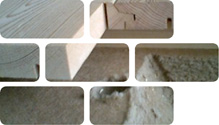
Structural Insulated Panels (SIPS) Composite 17 06 04
Structural insulated panels (SIPS) are a composite of two outer faces of board, profile, film or cladding system sandwiching a centre of insulation material that is mostly foam insulation but can be other types of insulation. SIPS are manufactured in a wide range of styles, sizes, thicknesses and finishes depending on the specification required. Testing for the presence of CFCs may be necessary.
Usage & Probable Locations
SIPS are used for floors, walls, roofs, doors, infill panels and extensions for most type of buildings. They are used extensively for sheeting and cladding, but increasingly used for whole building solutions that are manufactured offsite. SIPS are located on roofs, gable ends, external walls, floors, cold rooms, large doors and internal walls.
Personal Protective Equipment
PPE requirements indicated are for guidance purposes only. DRIDS has identified the PPE that is mandatory on all demolition projects and ones that may be required subject to site specific Risk Assessment & Method Statement (RAMS). Hover over the icon to determine the types of PPE required for the removal of this material.
Removal, Segregation & Storage
SIPS that are in good condition, not damaged and not coated with paints or other coatings may have some reuse value. They should be segregated and stored flat on a suitably sized pallet and away from plant movements. SIPS destined for recovery or recycling should be stored in a similar fashion or collected within a covered segregated skip to avoid contamination or contact with direct sunlight. SIPS destined for landfill should be segregated from any hazardous materials in a mixed waste skip.
Tools
Fixtures, Fittings & Connections
SIPS have been traditionally fixed in place with nails, screws, hook bolts, coach screws, bolts, rivets, buildex or drive nails. Quick build systems use a range of fixtures and fixings including dowels, snap-connections, specialist brackets, stud and ferules, tracks, clamps and hinges. SIPS containing plasterboard, steel profile sheets, foam insulation or insulating film are mostly bound together with adhesives and difficult to separate into their component parts for reuse, recycling or recovery of energy through incineration.
Health & Safety
Subject to task-specific Risk Assessment & Method Statement (RAMS). Use correct protective equipment and gloves when handling SIPS with damaged edges, sharp corners or coated in paints to prevent irritation, cuts and splinters. Wear eye protection when using hand tools. Do not walk on wet sheets. Only use harness protection at height as a last resort. Only use 360 plant, attachments or cutting tools if properly trained. Wear mask when cutting or breaking foam or fibre insulation to prevent inhalation.










